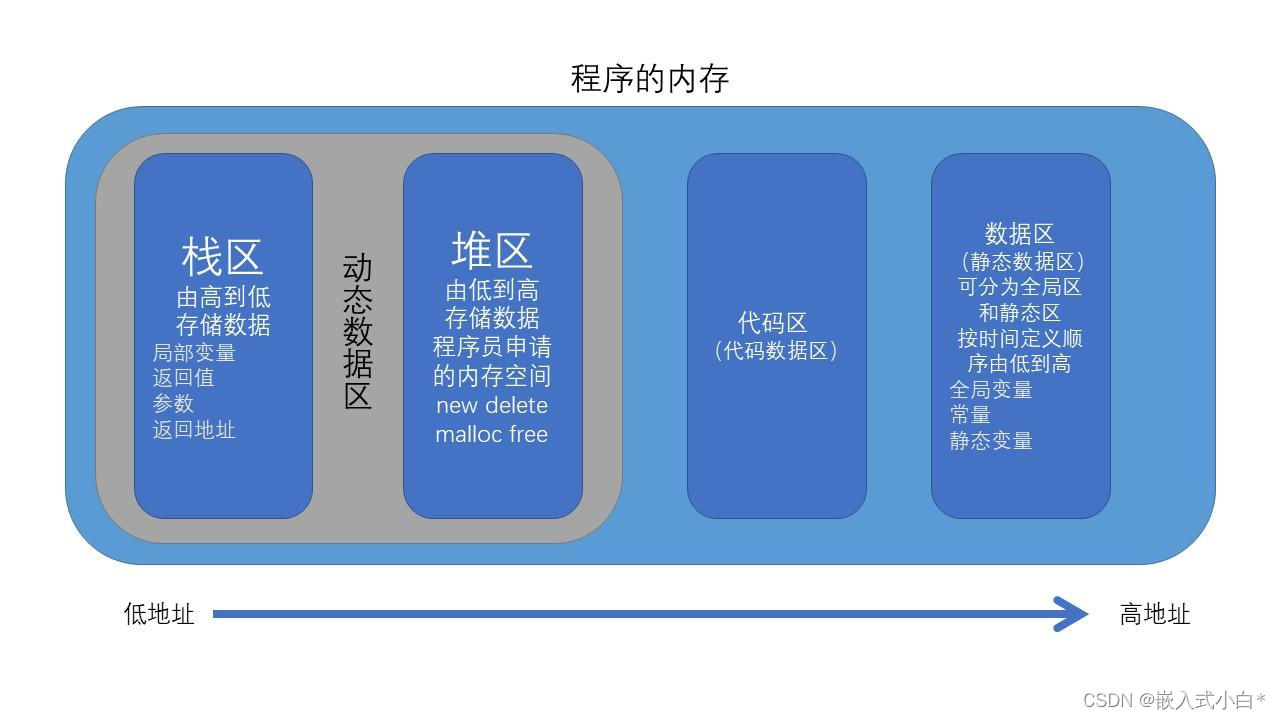系列文章目录
前言
C++在执行程序时会把内存划分为4块区域,为了我们高效地编程,而这些区域的作用是什么呢?下面就由我来介绍介绍
一、内存概述
- 代码区:存放函数体的二进制代码,由操作系统进行管理
- 全局区:存放全局变量、静态变量以及常量
- 栈区:由编译器自动分配释放,存放函数的参数值和局部变量等
- 堆区:由程序员动态分配和释放,若程序员不释放,程序结束时由操作系统释放


二、内存四区
1.代码区
- 存放CPU执行的机器指令
- 代码区是共享的,共享的目的是对于频繁被执行的程序,只需要在内存中有一份代码即可
- 代码区是只读的,使其只读的原因是防止程序意外地修改了它的指令
2.全局区解析
2.1测试程序
#define _CRT_SECURE_NO_WARNINGS
#include <iostream>
using namespace std;
//全局变量
int global_a;
int global_b;
//全局常量
const int global_con_a = 10;
const int global_con_b = 10;
int main()
{
//局部变量
int a;
int b;
cout << "局部变量a的地址为:" << reinterpret_cast<uintptr_t>(&a) << endl;
cout << "局部变量b的地址为:" << reinterpret_cast<uintptr_t>(&b) << endl;
//局部常量
const int con_a = 10;
const int con_b = 10;
cout << "局部常量con_a的地址为:" << reinterpret_cast<uintptr_t>(&con_a) << endl;
cout << "局部常量con_b的地址为:" << reinterpret_cast<uintptr_t>(&con_b) << endl;
//全局变量
cout << "全局变量a的地址为:" << reinterpret_cast<uintptr_t>(&global_a) << endl;
cout << "全局变量b的地址为:" << reinterpret_cast<uintptr_t>(&global_b) << endl;
//静态变量
static int sta_a;
static int sta_b;
cout << "静态变量sta_a的地址为:" << reinterpret_cast<uintptr_t>(&sta_a) << endl;
cout << "静态变量sta_b的地址为:" << reinterpret_cast<uintptr_t>(&sta_b) << endl;
//局部静态变量
static int sta_loc_a;
static int sta_loc_b;
cout << "局部静态变量sta_loc_a的地址为:" << reinterpret_cast<uintptr_t>(&sta_loc_a) << endl;
cout << "局部静态变量sta_loc_b的地址为:" << reinterpret_cast<uintptr_t>(&sta_loc_b) << endl;
//静态常量
static const int sta_con_a = 10;
static const int sta_con_b = 10;
cout << "静态常量sta_con_a的地址为:" << reinterpret_cast<uintptr_t>(&sta_con_a) << endl;
cout << "静态常量sta_con_b的地址为:" << reinterpret_cast<uintptr_t>(&sta_con_b) << endl;
//字符串常量
cout << "字符串常量的地址为:" << reinterpret_cast<uintptr_t>(&"hello world") << endl;
//全局常量
cout << "全局常量global_con_a的地址为:" << reinterpret_cast<uintptr_t>(&global_con_a) << endl;
cout << "全局常量global_con_b的地址为:" << reinterpret_cast<uintptr_t>(&global_con_b) << endl;
return 0;
}
2.2输出

从输出结果可以看出局部变量和局部常量是紧挨着的,存储在栈区并且存储方式是由高到低的,全局变量、静态变量、局部静态变量是紧挨着的,存储在全局区并且存储方式是由低到高的,静态常量、字符串常量、全局常量是紧挨着的,存储在常量区并且存储方式是由低到高的。
2.3总结
- 全局变量和静态变量存放在此
- 全局区还包含了常量区、字符串常量和其他常量也存放在此
- 该区域的数据在程序结束后由操作系统释放
3.栈区解析
3.1测试程序
#define _CRT_SECURE_NO_WARNINGS
#include <iostream>
using namespace std;
int* func()
{
int a = 10;
return &a;
}
int main()
{
int* p = func();
cout << *p << endl;
cout << *p << endl;
return 0;
}3.2输出

3.3总结
- 局部变量和局部常量存储在栈区
- 全局变量、静态变量、局部静态变量存放在全局区
- 静态常量、字符串常量、全局常量存储在常量区
4.堆区解析
3.1测试程序
在堆区开辟内存时需要用new关键字,而释放内存时需要用delete关键字
#define _CRT_SECURE_NO_WARNINGS
#include <iostream>
using namespace std;
int* func()
{
int* p = new int(10);//在堆区创建整型数据
return p;
}
int* func2()
{
int* arr = new int[10];//在堆区创建数组
for (int i = 0; i < 10; i++)
{
arr[i] = i + 100;
}
return arr;
}
int main()
{
int* p = func();
cout << *p << endl;
int* arr = func2();
for (int i = 0; i < 10; i++)
{
cout << arr[i] << endl;
}
//释放堆区数据
delete p;
delete[] arr;
return 0;
}4.2输出
10
100
101
102
103
1043.总结
以上就是今天要讲的内容,本文简单介绍了C++中内存的四大分区,并且用代码更直观地表现了数据在内存中的存储方式。





















 636
636











 被折叠的 条评论
为什么被折叠?
被折叠的 条评论
为什么被折叠?








